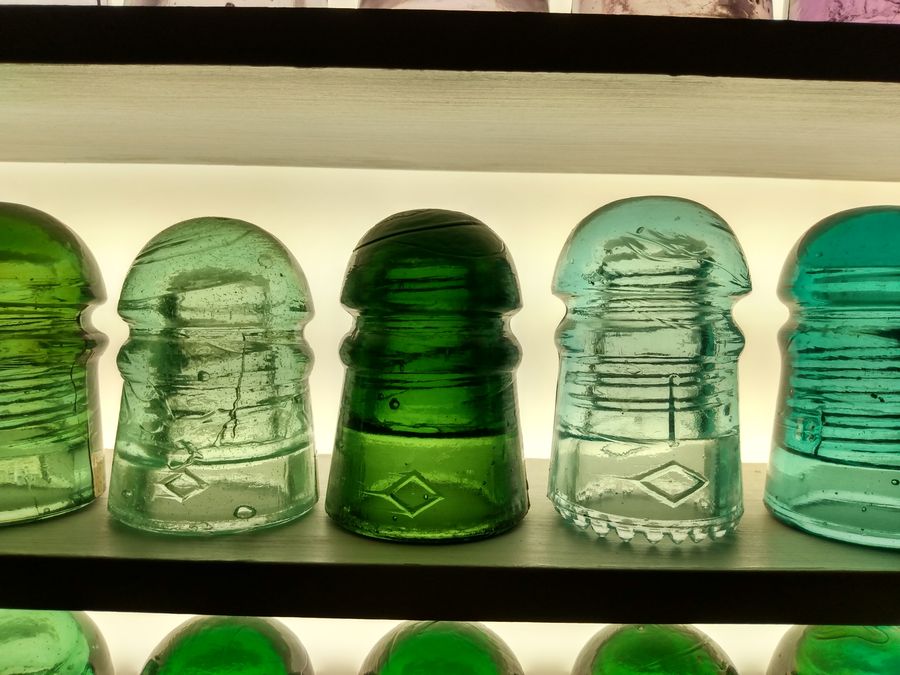102 Shooting Stars, 102 Speed Diamonds Question
By Mike O'Loughlin; posted December 15, 2020
View Original: Click to zoom, then click to magnify (3264 x 2448) 1891KB

|
Shown are a few minor "Speed Diamonds" (I don't have or know a better term) there is raised material streaming to left from high points on embossing. I have also seen "Shooting Stars" there's one on ICON now. It too has glass streaming to left. I have seen a few other stars and diamonds, -lines always to the left..?? I like to think I understand the molding process a little bit, but I don't understand how or why it occurs. It appears to be metal removed from mold to create this affect, but I can't for the life of me understand how this happened (if accidental), or why it would be done if it were on purpose. I have a 102 B that has the same effect, however, I believe that one is a stamped B that was relief cut to be near left mold line (as if it were going to be embossed BROOKFIELD), but then they centered it. -But them shooting stars and speed diamonds??? Update: Paul Greaves has given the best explanation yet. I'm still trying to wrap my mind around it, but it goes something like this:(poorly paraphrased) As the thread mandrel is removed, it is unscrewed (turned to left). While this should happen with insulator held in place in mold, if the mold is opened during mandrel unthreading, (or still unthreading) the insulator will tend to turn left with the mandrel, scraping the lower points on the mold, causing streaking. While I admit I am having a little trouble "seeing it in my mind" I do believe that this is the best explanation. There's a lot going on there, in rapid succession, and the geometry of how the mold is hinged is likely to come into play. I can't imagine anyone filing the streaks and ramps into the mold, or that happening through normal wear. Thanks Paul! Just had a thought that goes along with the mandrel removal movement stuff. It's kinda nuts, but that's my thing. Anyways here goes: As the insulator hardens/crystalizes the embossing becomes hard(abrasive). The mandrel is unscrewing as the mold opens. Because the glass has hardened sufficiently there is enough friction to scrape the high points of the embossing against the mold. One by one, each insulator made actually abrades the mold (scratches it -Embosses the mold) TO THE LEFT! I believe this could account for the streaks even passing the mold line as it does in some examples. I now also think that it relates to what I had previously **Assumed** to be mold repairs. (Those slightly raised lines that go all the way around the insulator making it look like the lower part of mold has been cut off and replaced) That "seam" may just be a scratch in some instances. I had previously been looking at the problem as "How does the mold do this to the insulator, when I should have been looking at it as "what is the insulator doing to the mold?" No? Yes? No! No! Yes? -C'mon give it up! So the mold shapes the insulator, but the insulator shapes the mold...(Progressive mold damage) You got a better explanation? -Let's hear it! (This may be exactly what Paul was trying to get through my head, but since my brain moves slowly, I have to see it happening in slow motion...and from the proper perspective) Anyways thanks again Paul! My brain can start healing. update: Paul has confirmed that I have been able to awkwardly describe what he was trying to get through my thick skull. I have also gotten information from a Canadian collector telling me that those diamond molds were not automated. This actually makes more sense because a crew working manual molds (for piece rate wages) would be inclined to rush every aspect of their production. Thanks Dave! His thoughts were very much on point with my first approach at trying to understand this phenomenon, however I have gone to the dark side with Paul on this one. One last interesting fact : If you look up the hardness of materials, you will find that glass and a steel knife blade are of equal hardness. Think about that if you are in doubt as to wether insulators could damage molds. |